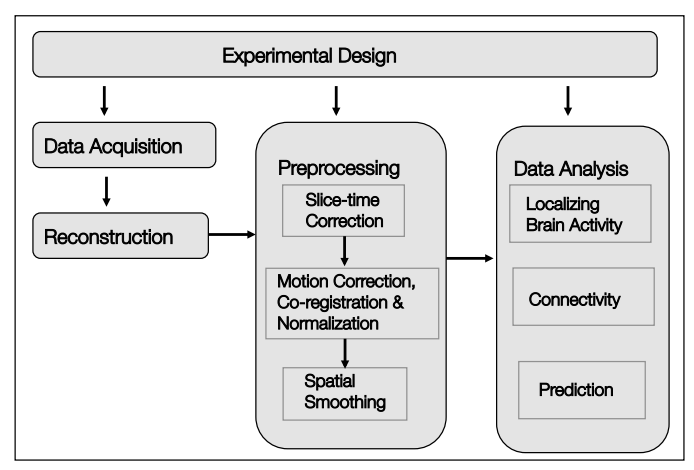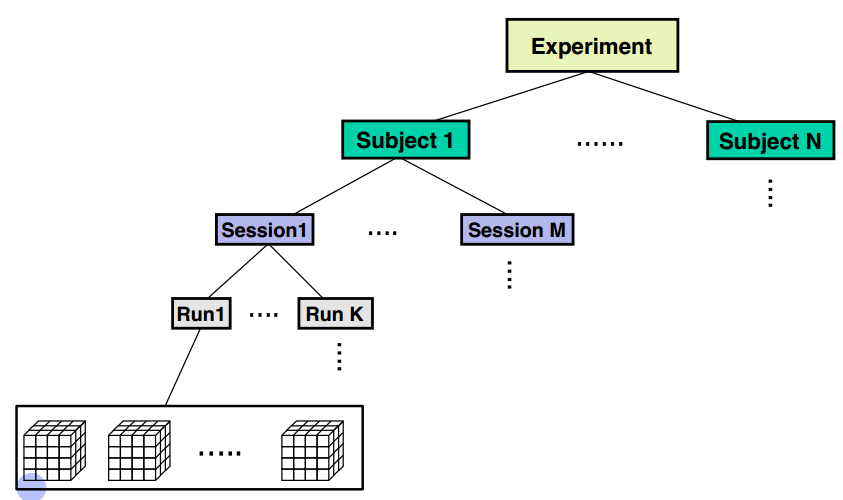问题:
1. fMRI能做什么不能做什么?
第一周:fMRI简介,data acquisition and reconstruction
大致分为两类:
- Structural brain imaging(CAT,MRI,PET)
- Functional brain imaging(PET,fMRI,EEG,MEG)
每个方法都有自己的spatial resolution, temporal resolution and invasiveness.
Functional MRI provides a nice balance between these properties and has become the dominant functional imaging modality in the past decade.

Changes in the measured signal between individual images are used to make inferences regarding task-related activations in the brain.
Each image consists of ~100,000 'voxels' (cubic volumes that span the 3D space of the brain).
During the course of an experiment several hundred images are acquired (~ one every 2s)
Tracking the intensity over time gives us a time series.
fMRI的处理是一个难题:
The statistical analysis of fMRI data is challenging.
- It is a massive data problem.
- The signal of interest is relatively weak.
- The data exhibits a complicated temporal and spatial noise structure.

三大应用:
- Localization
- Connectivity
- Prediction
fMRI Data Structure数据结构
Consists of both structural and functional data.
When designing an fMRI experiment one must balance the need for adequate spatial resolution with that of adequate temporal resolution.
The temporal resolution determines our ability to separate brain events in time.
In fMRI the temporal resolution is determined by how quickly each individual image is acquired (TR).
The spatial resolution determines our ability to distinguish changes in an image across different spatial locations.
一些术语Terminology
Structural (T1) images:
High spatial resolution
Low temporal resolution
Can distinguish different types of tissue
Functional (T2*) images:
Lower spatial resolution
Higher temporal resolution
Can relate changes in signal to an experimental manipulation
三个方向:Coronal ,Sagittal ,Axial 
Field of View (FOV)
Slice thickness
Matrix Size
Voxel Size


Psychological Questions and Inference 心理学问题和推理

What is the question?
The key: Whether a target brain region is active or not must constrain your theory teach you something new).
Forward and reverse inference
To learn something about the mind, you need reverse inference.
Brain mapping approaches provide forward inference

Inference, sensitivity, and specificity
If I’m enjoying something, then my caudate is activated. This can be quantified in terms of sensitivity: P(caudate | enjoyment)
Quantified in terms of specificity: 1 - P(caudate | NOT enjoyment)
Reverse inference take-home
Reverse inference can be done
Strategy 1: Leverage neuroscience
– Strong prior knowledge about psycholgocial processes that do (and don’t) activate a brain area
– Assume that activation implies psychological process
Strategy 2: Quantitative reverse inference
– Assess activation of a region (or other brain measure) across candidate set of tasks
– Quantify its sensitivity, specificity, and positive and negative predictive values
– May require testing many tasks, contexts, and study populations
What brain mapping is good for?
Making inferences on the presence of activity, to either a) test a theory, or b) characterize the pattern of brain responses to a task.
Limiting the false positive rate to a specified level.
Leverage hypothesis testing to provide evidence on a variety of theories: Is Area r involved in Task x?
What brain mapping is not good for?
Reverse inference:
– Does not provide direct inferences about psychological states
– Need clever experimental designs, specialized analyses, metaanalyses
Establishing meaningful effects:
– Terrible for estimating effect sizes and predictive accuracy
Testing assumptions
– Inference depends on many assumptions
– You must check these yourself (more on this later)
Comparing evidence for different theories
– Just because a model shows some effect it does not mean it’s the best model (or even close).
– Cannot confirm theories, only falsify them.
A Bayesian Model of Category-Specific Emotional Brain Responses
Disease state prediction from resting state functional connectivity
待续~